Abstract
A plasmid-borne gene mediating trimethoprim resistance, dhfrIX, newly found among porcine strains of Escherichia coli, was observed at a frequency of 11% among trimethoprim-resistant veterinary isolates. This rather high frequency of dhfrIX could be due to the extensive use of trimethoprim in veterinary practice in Sweden. After searching several hundred clinical isolates, one human E. coli strain was also found to harbor the dhfrIX gene. Thus, the dhfrIX gene seems to have spread from porcine bacteria to human pathogens. Furthermore, the occurrence of other genes coding for resistant dihydrofolate reductase enzymes (dhfrI, dhfrII, dhfrV, dhfrVII, and dhfrVIII) among the porcine isolates was investigated. In addition, association of dhfr genes with the integraselike open reading frames of transposons Tn7 and Tn21 was studied. In colony hybridization experiments, both dhfrI and dhfrII were found associated with these integrase genes. The most common combination was dhfrI and int-Tn7, indicating a high prevalence of Tn7.
Full text
PDF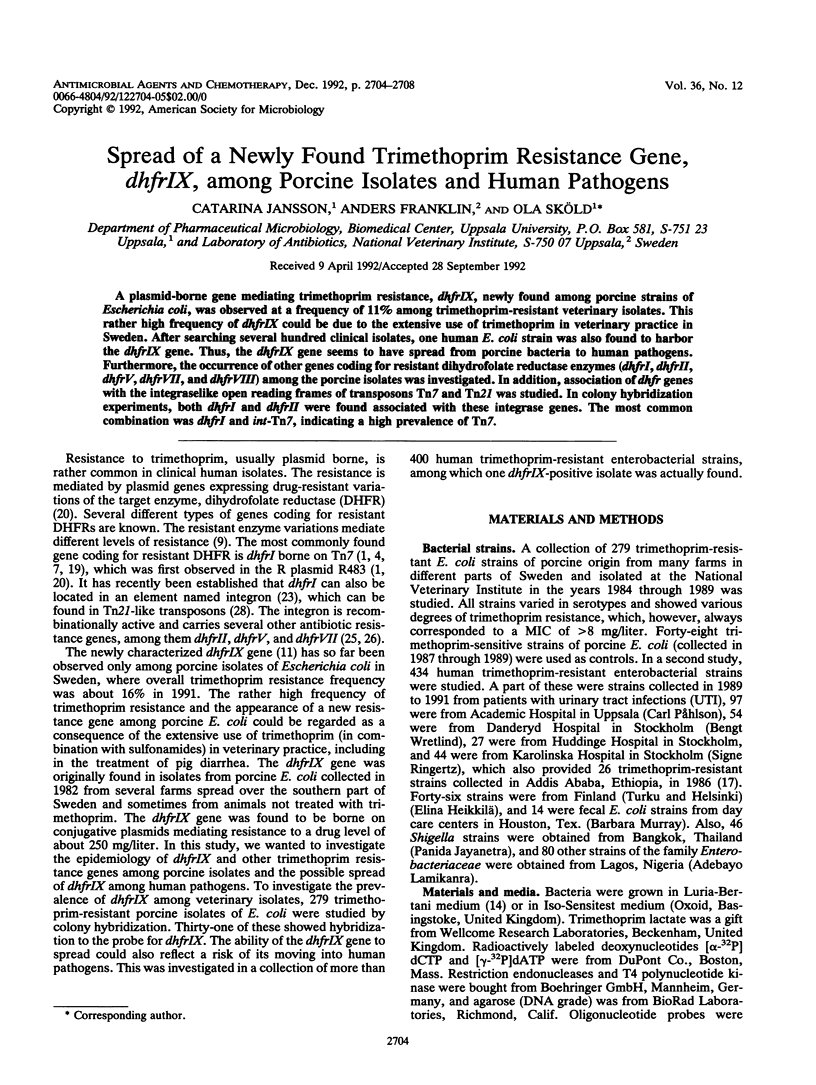
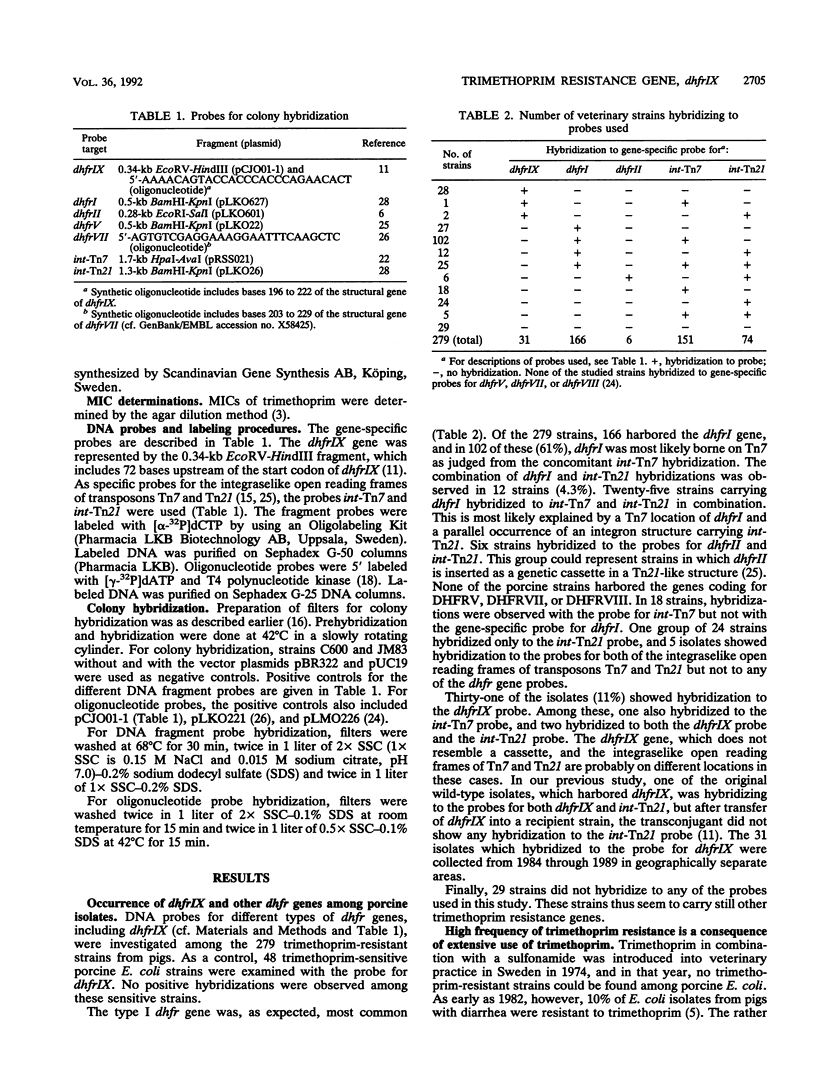
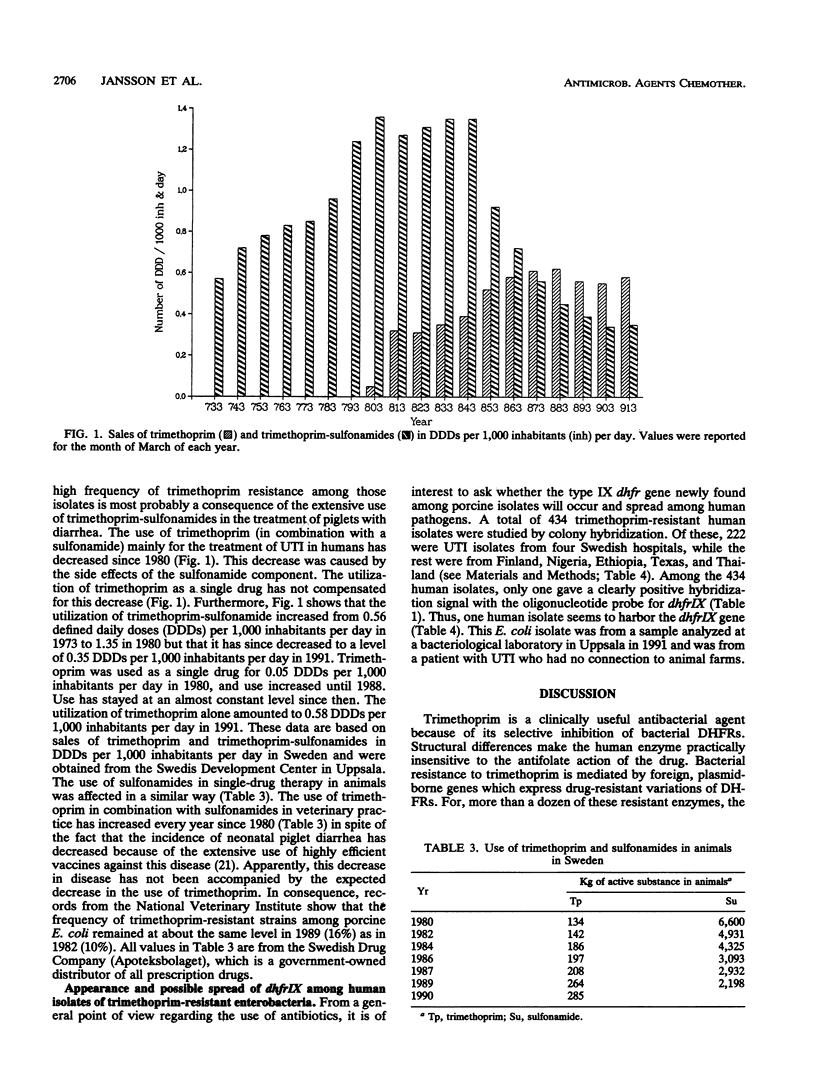
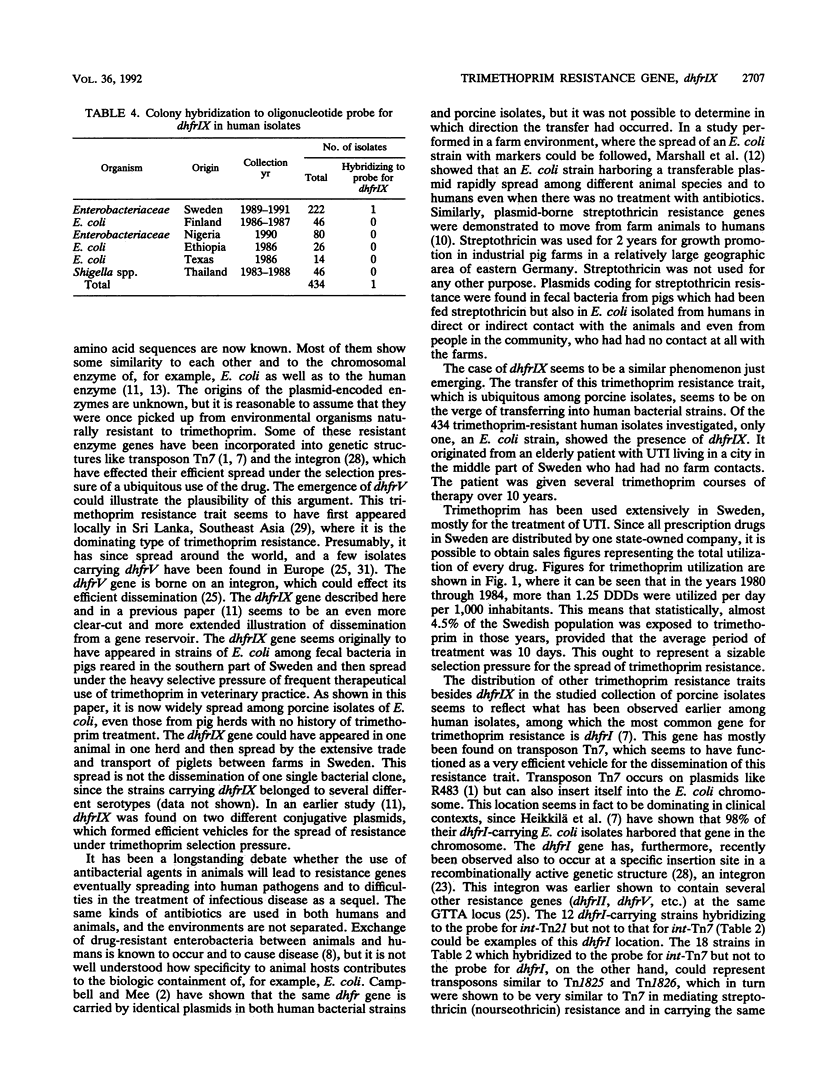
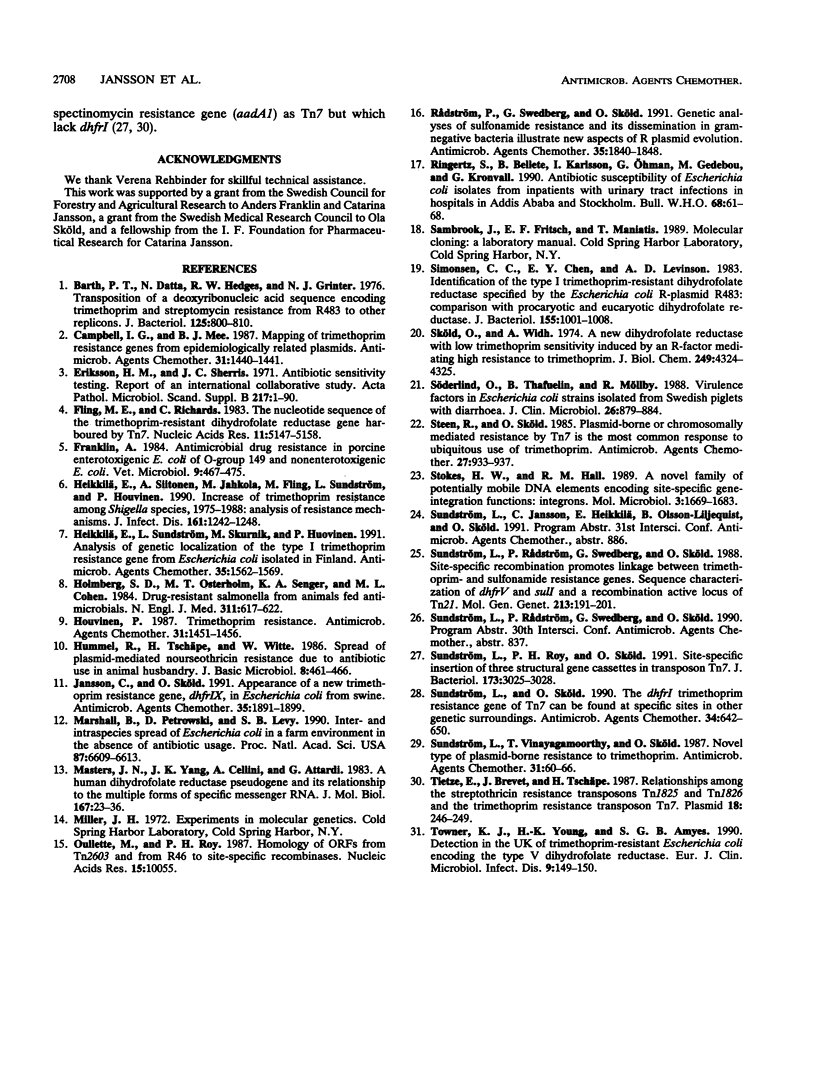
Selected References
These references are in PubMed. This may not be the complete list of references from this article.
- Barth P. T., Datta N., Hedges R. W., Grinter N. J. Transposition of a deoxyribonucleic acid sequence encoding trimethoprim and streptomycin resistances from R483 to other replicons. J Bacteriol. 1976 Mar;125(3):800–810. doi: 10.1128/jb.125.3.800-810.1976. [DOI] [PMC free article] [PubMed] [Google Scholar]
- Campbell I. G., Mee B. J. Mapping of trimethoprim resistance genes from epidemiologically related plasmids. Antimicrob Agents Chemother. 1987 Sep;31(9):1440–1441. doi: 10.1128/aac.31.9.1440. [DOI] [PMC free article] [PubMed] [Google Scholar]
- Fling M. E., Richards C. The nucleotide sequence of the trimethoprim-resistant dihydrofolate reductase gene harbored by Tn7. Nucleic Acids Res. 1983 Aug 11;11(15):5147–5158. doi: 10.1093/nar/11.15.5147. [DOI] [PMC free article] [PubMed] [Google Scholar]
- Franklin A. Antimicrobial drug resistance in porcine enterotoxigenic Escherichia coli of 0-group 149 and non-enterotoxigenic Escherichia coli. Vet Microbiol. 1984 Sep;9(5):467–475. doi: 10.1016/0378-1135(84)90067-1. [DOI] [PubMed] [Google Scholar]
- Heikkilä E., Sundström L., Skurnik M., Huovinen P. Analysis of genetic localization of the type I trimethoprim resistance gene from Escherichia coli isolated in Finland. Antimicrob Agents Chemother. 1991 Aug;35(8):1562–1569. doi: 10.1128/aac.35.8.1562. [DOI] [PMC free article] [PubMed] [Google Scholar]
- Holmberg S. D., Osterholm M. T., Senger K. A., Cohen M. L. Drug-resistant Salmonella from animals fed antimicrobials. N Engl J Med. 1984 Sep 6;311(10):617–622. doi: 10.1056/NEJM198409063111001. [DOI] [PubMed] [Google Scholar]
- Hummel R., Tschäpe H., Witte W. Spread of plasmid-mediated nourseothricin resistance due to antibiotic use in animal husbandry. J Basic Microbiol. 1986;26(8):461–466. doi: 10.1002/jobm.3620260806. [DOI] [PubMed] [Google Scholar]
- Huovinen P. Trimethoprim resistance. Antimicrob Agents Chemother. 1987 Oct;31(10):1451–1456. doi: 10.1128/aac.31.10.1451. [DOI] [PMC free article] [PubMed] [Google Scholar]
- Jansson C., Sköld O. Appearance of a new trimethoprim resistance gene, dhfrIX, in Escherichia coli from swine. Antimicrob Agents Chemother. 1991 Sep;35(9):1891–1899. doi: 10.1128/aac.35.9.1891. [DOI] [PMC free article] [PubMed] [Google Scholar]
- Marshall B., Petrowski D., Levy S. B. Inter- and intraspecies spread of Escherichia coli in a farm environment in the absence of antibiotic usage. Proc Natl Acad Sci U S A. 1990 Sep;87(17):6609–6613. doi: 10.1073/pnas.87.17.6609. [DOI] [PMC free article] [PubMed] [Google Scholar]
- Masters J. N., Yang J. K., Cellini A., Attardi G. A human dihydrofolate reductase pseudogene and its relationship to the multiple forms of specific messenger RNA. J Mol Biol. 1983 Jun 15;167(1):23–36. doi: 10.1016/s0022-2836(83)80032-1. [DOI] [PubMed] [Google Scholar]
- Ouellette M., Roy P. H. Homology of ORFs from Tn2603 and from R46 to site-specific recombinases. Nucleic Acids Res. 1987 Dec 10;15(23):10055–10055. doi: 10.1093/nar/15.23.10055. [DOI] [PMC free article] [PubMed] [Google Scholar]
- Ringertz S., Bellete B., Karlsson I., Ohman G., Gedebou M., Kronvall G. Antibiotic susceptibility of Escherichia coli isolates from inpatients with urinary tract infections in hospitals in Addis Ababa and Stockholm. Bull World Health Organ. 1990;68(1):61–68. [PMC free article] [PubMed] [Google Scholar]
- Simonsen C. C., Chen E. Y., Levinson A. D. Identification of the type I trimethoprim-resistant dihydrofolate reductase specified by the Escherichia coli R-plasmid R483: comparison with procaryotic and eucaryotic dihydrofolate reductases. J Bacteriol. 1983 Sep;155(3):1001–1008. doi: 10.1128/jb.155.3.1001-1008.1983. [DOI] [PMC free article] [PubMed] [Google Scholar]
- Steen R., Sköld O. Plasmid-borne or chromosomally mediated resistance by Tn7 is the most common response to ubiquitous use of trimethoprim. Antimicrob Agents Chemother. 1985 Jun;27(6):933–937. doi: 10.1128/aac.27.6.933. [DOI] [PMC free article] [PubMed] [Google Scholar]
- Stokes H. W., Hall R. M. A novel family of potentially mobile DNA elements encoding site-specific gene-integration functions: integrons. Mol Microbiol. 1989 Dec;3(12):1669–1683. doi: 10.1111/j.1365-2958.1989.tb00153.x. [DOI] [PubMed] [Google Scholar]
- Sundström L., Vinayagamoorthy T., Sköld O. Novel type of plasmid-borne resistance to trimethoprim. Antimicrob Agents Chemother. 1987 Jan;31(1):60–66. doi: 10.1128/aac.31.1.60. [DOI] [PMC free article] [PubMed] [Google Scholar]
- Tietze E., Brevet J., Tschäpe H. Relationships among the streptothricin resistance transposons Tn1825 and Tn1826 and the trimethoprim resistance transposon Tn7. Plasmid. 1987 Nov;18(3):246–249. doi: 10.1016/0147-619x(87)90067-9. [DOI] [PubMed] [Google Scholar]
- Towner K. J., Young H. K., Thomson C. J., Amyes S. G. Detection in the UK of trimethoprim-resistant Escherichia coli encoding the type V dihydrofolate reductase. Eur J Clin Microbiol Infect Dis. 1990 Feb;9(2):149–150. doi: 10.1007/BF01963646. [DOI] [PubMed] [Google Scholar]


